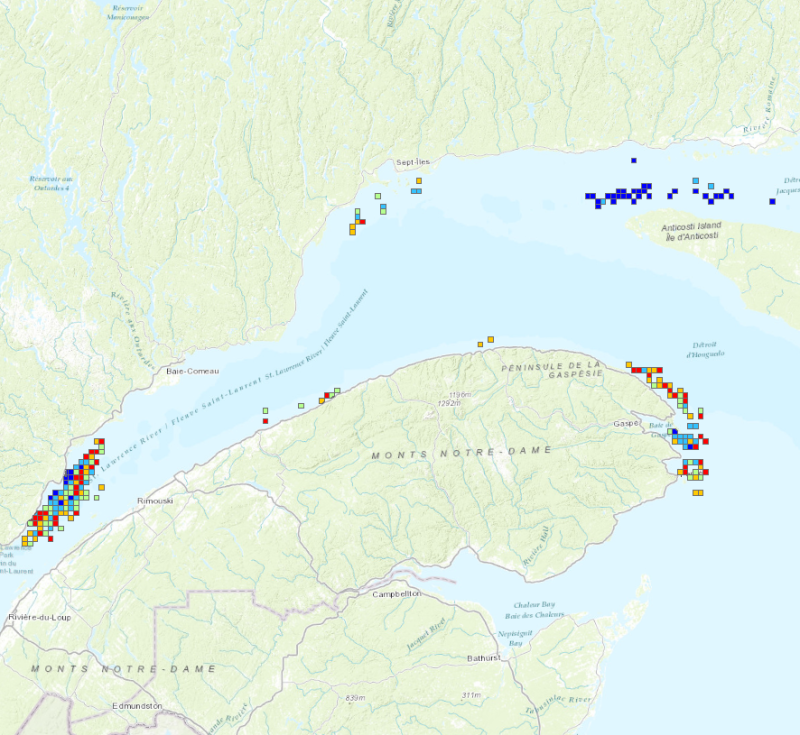Sighting
Type of resources
Topics
Keywords
Provided by
Representation types
Update frequencies
status
-

General distribution of Humpback Whales in the Estuary and Gulf of St. Lawrence based on all identified whales from the entire MICS database (Mingan Island Cetacean Study). Additional information The MICS (Mingan Island Cetacean Study) has been collecting and compiling in a photo-identification catalogue, blue whale (and other type of whales) sightings for the western North Atlantic since 1979. Since 1987, the material and sampling protocol has been being relatively stable, neither random nor systematic. Field work is conducted abord inflatable boats. Because the whole Gulf ot St. Lawrence cannot be thoroughly studied, MCIS conducts surveys in known whale aggregation areas. The spatial effort is also weather dependent and is mainly constrained by wind direction and strength. Therefore, the study area is not homogeneously covered. Each whale observation is associated with a picture that allows individual identification based on the animal's pigmentation pattern. For more details consult the mentionned report: Gagné, J.A., Ouellet, P., Savenkoff, C., Galbraith, P.S., Bui, A.O.V. et Bourassa, M.-N. Éd. 2013. Rapport intégré de l’initiative de recherche écosystémique (IRÉ) de la région du Québec pour le projet : les espèces fourragères responsables de la présence des rorquals dans l’estuaire maritime du Saint-Laurent. Secr. can. de consult. sci. du MPO. Doc. de rech. 2013/086. vi + 181 p.
-

Sightings data were collected by the Mingan Island Cetacean Study (MICS) from 1980 to 2008 with annual surveys realised in the Gulf of St. Lawrence between the end of may and early november. Surveys were conducted using inflatable boats enabling the close approaches necessary to photograph and biopsy blue whales. The aim of this project was to provide additional information for designating blue whale critical habitat as required under the Canadian Species at Risk Act. For more details consult the following report: Ramp, C. and Sears, R. 2013. Distribution, densities, and annual occurrence of individual blue whales (Balaenoptera musculus) in the Gulf of St. Lawrence, Canada from 1980-2008. DFO Can. Sci. Advis. Sec. Res. Doc. 2012/157. vii + 37 p. http://www.dfo-mpo.gc.ca/csas-sccs/Publications/ResDocs-DocRech/2012/2012_157-eng.html Data of blue whale sightings, collected by the MICS, have been analysed per km of effort in 3 x 3 km grid cells in the Gulf of St. Lawrence for the 2000-2008 period.
-

Layers that present various important parameters such as inventories, presence, sightings, distribution, relative occurrence or catch rates, critical habitat, breeding and feeding areas, potential spawning and haul-out sites for the different species with status under the Species at Risk Act (SARA). The act classifies those species as being either extirpated, endangered, threatened, or of special concern. Under SARA, Fisheries and Oceans Canada must produce recovery strategies and action plans for aquatic species listed as endangered or threatened. The act is part of Canada’s strategy to protect hundreds of wild plants and animal species from becoming extinct, and to help in their recovery. The different species represented by the layers are the following: 1. American shad (Alosa sapidissima) 2. Atlantic sturgeon (Acipenser oxyrinchus) 3. Atlantic wolffish (Anarhichas lupus) 4. Beluga whale (Delphinapterus leucas) 5. Blue whale (Balaenoptera musculus) 6. Copper redhorse (Moxostoma hubbsi) 7. Eelgrass (Zostera marina) 8. Grey seal (Halichoerus grypus) 9. Harbor seal (Phoca vitulina) 10. Humpback whale (Megaptera novaeangliae) 11. Lake sturgeon (Acipenser fulvescens) 12. Lumpfish (Cyclopterus lumpus) 13. Northern wolffish (Anarhichas denticulatus) 14. Rainbow smelt (Osmerus mordax) 15. Sea pens (Pennatulacea) 16. Seaweed 17. Smooth skate (Malacoraja senta) 18. Sponges 19. Spotted wolffish (Anarhichas minor) 20. Striped bass (Morone saxatilis) 21. Thorny skate (Amblyraja radiata) 22. Winter skate (Leucoraja ocellata)
 Arctic SDI catalogue
Arctic SDI catalogue